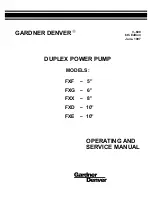
Inst
allation
TPE E-circulators
13
41
Vibration dampers
To prevent the transmission of vibrations to buildings,
we recommend you to isolate the pump foundation
from building parts by means of vibration dampers.
The selection of the right vibration damper requires the
following data:
• forces transmitted through the damper
• motor speed considering speed control, if any
• required dampening in % (suggested value is 70 %).
Which is the right damper varies from installation to
installation, and a wrong damper may increase the
vibration level. Vibration dampers should therefore be
sized by the supplier.
If you install the pump on a foundation with vibration
dampers, always fit expansion joints on the pump
flanges. This is important to prevent the pump from
"hanging" in the flanges.
Expansion joints
Install expansion joints to:
• absorb expansions/contractions in the pipework
caused by changing liquid temperature
• reduce mechanical strains in connection with
pressure surges in the pipework
• isolate mechanical structure-borne noise in the
pipework (only rubber bellows expansion joints).
Note:
Do not install expansion joints to compensate
for inaccuracies in the pipework such as center
displacement of flanges.
Fit expansion joints at a distance of minimum 1 to 1½
times the nominal flange diameter away from the pump
on the suction as well as on the discharge side. This
will prevent the development of turbulence in the
expansion joints, resulting in better suction conditions
and a
minimum pressure loss on the pressure side. At high
water velocities (> 16 ft/s) we recommend you to install
larger expansion joints corresponding to the pipework.
The illustration below shows examples of rubber
bellows expansion joints with or without limit rods.
Fig. 14
Examples of rubber bellows expansion joints
Expansion joints with limit rods can be used to reduce
the effects of the expansion/contraction forces on the
pipework.
Anchor the pipes in such a way that they do not stress
the expansion joints and the pump. Follow the
supplier’s instructions and pass them on to advisers or
pipe installers.
The illustration below shows an example of a metal
bellows expansion joint with limit rods.
Fig. 15
Example of metal expansion joint
Due to the risk of rupture of the rubber bellows, metal
bellows expansion joints may be preferred a
temperatures above +212 °F (100 °C) combined with
high pressure.
Control panel positions
As standard, the control panels of TP and TPE pumps
are mounted in position 9 o’clock.
The possible terminal box positions are shown below.
Control panel face has an infrared receiver. There
should be sufficient space between any obstruction
and the control panel.
TM
02
49
79
19
02
-
TM0
2
498
1
190
2
TM
02
49
80
19
02
TM
03 056
5 200
5
Stellung 6
Stellung 9
Stellung 12
Stellung 3
Position
6 o’clock
Position
3 o’clock
Position
9 o’clock
Standard
Position
12 o’clock
E-circulator.book Page 41 Friday, October 7, 2011 4:01 PM
Содержание TP 100-160
Страница 48: ...48 This page intentionally left blank ...
Страница 49: ...49 This page intentionally left blank ...
Страница 50: ...50 This page intentionally left blank ...
Страница 51: ...51 This page intentionally left blank ...












































